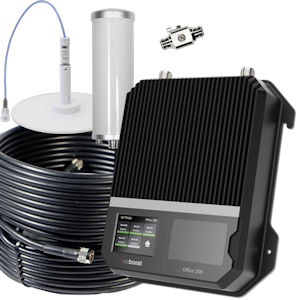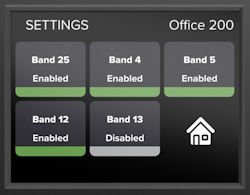What are the differences between the weBoost Office 100, Office 200, and Office 300 Installed?
Updated
In this review, we’ll compare the weBoost Office 100 (472060, 473060) with the weBoost Office 200 (471047, 472047) and weBoost Office 300 Installed (479047).
These commercial cell signal boosters from Wilson Electronics improve indoor cell signal reception in small offices and small business spaces. Which one is right for you? Let’s explore their similarities and their differences.
Where they’re the same
Some features are identical in the weBoost Office 100, Office 200, and Office 300 Installed. These include:
- Cellular frequencies supported:
- 700 MHz (SMH bands 12, 17, 13)
- 850 MHz (CLR band 5)
- 1700/2100 MHz (AWS band 4)
- 1900 MHz (PCS bands 2, 25)
- Gain control: Automatic (AGC)
- Amplifier design: Metal housing
- Impedance: Choice of 50 ohm or 75 ohm (Office 300 75 ohm only)
- Connectors: Choice of N connectors (50 Ω) or F connectors (75 Ω) (Office 300 F connectors only)
- Manufacturer’s warranty: 3 years
- Certifications: FCC and carrier preapproval (no operating license required)
The weBoost Office 100, Office 200, and Office 300 Installed are all capable amplifiers that work on the major frequencies that will continue to be the backbone of cellular service for many years to come. They operate at the maximum possible gain permitted by the FCC.
Except for the Office 300 Installed, they are available in the two industry standard impedance, connector, and cable types found on commercial cellular amplifiers.
Where they differ
Actual max uplink gain
While the weBoost Office 100, Office 200, and Office 300 Installed are all advertised as 72 dB boosters, actual test figures show that the weBoost Office 200 and 300 have higher gain thresholds than the Office 100—in other words, they come closer to the FCC’s 72 dB limit before automatic gain control (AGC) kicks in.
These maximum uplink gain figures are from test reports submitted by Wilson Electronics to the FCC:
As the data indicate, the weBoost Office 200 and Office 300 have more maximum uplink gain than the weBoost Office 100, especially in lower-frequency cellular bands. This gives them a slight (but not inconsequential) performance edge.
Maximum power output
- Uplink power is the amount of output power (measured in decibel-milliwatts or dBm) the booster uses to communicate with the cell tower’s antenna. The more uplink power, the farther the booster can reach to distant towers.
- Downlink power is the amount of power the booster uses to reach cellular phones and devices inside the building. The more downlink power, the larger the area of indoor coverage and the greater the booster’s ability to penetrate walls and floors to reach phones.
These figures are from specifications published in weBoost’s user manuals:
The weBoost Office 100, Office 200, and Office 300 are fairly close in uplink power, with the Office 100 having an average of 21% more more uplink power, with most of it concentrated in the long-distance, low-frequency 700 and 850 MHz bands. If your office or building is in a remote area, far from cellular towers, the weBoost Office 100 may perform slightly better for you.
The weBoost Office 200 and Office 300 have 40 to 90% more downlink power than the Office 100; with it, they can provide stronger inside signal and a larger coverage area in most situations. For this reason, the weBoost Office 200 or Office 300 are better choices for larger offices (something we’ll cover below).
Dimensions & weight
- weBoost Office 100: 6.0″ w × 6.2″ h* × 1.6″ d × 2.14 lbs. (15.3 cm w × 15.8 cm h* × 4.0 cm d × 0.97 kg)
- weBoost Office 200 & Office 300 Installed: 9.1″ w × 10.4″ h* × 2.0″ d × 6.37 lbs. (32.1 cm w × 26.5 cm h* × 5.1 cm d × 2.89 kg)
* Height measurement includes N‑male connector posts.
The weBoost Office 200 and Office 300 are 3.2 times the size (in volume) and 3 times the weight of the weBoost Office 100. With their increased size and weight comes increased performance, but you will need a larger area on your wall to mount them.
XDR technology
- weBoost Office 100: No overload protection
- weBoost Office 200 & Office 300 Installed: XDR overload prevention
Many commercial cell signal amplifiers operate in situations where outside cellular signal is strong but unable to penetrate the building’s concrete or metal walls and low-e glass. When outside signal is too strong, the weBoost Office 100 shuts off any frequencies that are overloaded. In those situations, professional installers must use attenuators to reduce the signal received by the amplifier across all bands, even if the problem is only a specific band that’s too strong.
The weBoost Office 200 and Office 300 incorporate Wilson Electronics’s patented XDR (eXtended Dynamic Range) technology that prevents signal overload and amplifier shut down. When the amplifier detects that any band of incoming signal is too strong, XDR automatically reduces its gain to maintain the strongest possible signal coverage throughout the building.
Inside antennas
- weBoost Office 100: 1 or 2
- weBoost Office 200: 1 to 4
- weBoost Office 300 Installed: 2
The Office 100 and Office 200 come standard with one inside antenna. If you have a long-and-narrow building or an L-shaped or multi-story building, additional inside antennas can help you spread the signal coverage around more evenly. weBoost Office systems with the high-gain EDGE dome antenna are available exclusively from Powerful Signal. The Office 100 is available with 2 inside dome antennas; the Office 200 is available with up to 4 inside dome antennas.
The Office 300 Installed includes 2 low-profile Wilson dome antennas.
Coax cable
- weBoost Office 100 & Office 200: 400-type or RG11
- weBoost Office 300 Installed: RG6
The Office 100 and Office 200 use 50-ohm 400-type coax or 75-ohm RG11 coax. These types of cables have relatively low signal loss (attenuation); they allow for longer runs of cable with a larger indoor area of signal coverage.
The weBoost Office 300 Installed uses RG6 coax cable provided by the installer. RG6 has nearly double the signal loss per foot of 400-type and RG11 coax, so it requires shorter runs to provide the same indoor coverage area as the Office 200. Since the technician is going to custom cut RG6 coax during installation, the length of your cable runs will depend on the size and layout of your building.
Professional installation
- weBoost Office 100 & Office 200: Not available
- weBoost Office 300 Installed: Included
weBoost Office 100 and Office 200 systems require self-installation or hiring an electrician or other professional to do the installation for you.
If you prefer a solution with installation included, the weBoost Office 300 Installed includes professional, commercial installation by a licensed, insured, and manufacturer-certified installer. (Installation is available for businesses only, not for residential use.)
Open space indoor coverage
- weBoost Office 100 & Office 300 Installed: Up to 15,000 ft2
- weBoost Office 200: Up to 30,000 ft2
With its higher maximum uplink gain, increased downlink power output, XDR overload protection, and lower-loss coax cables, the weBoost Office 200 has a considerable coverage advantage over the weBoost Office 100 and Office 300 Installed. Because of this, the Office 200 is our recommended solution for midsized offices up to 30,000 square feet. We also recommend it for smaller offices that have strong outside cell signal.
The weBoost Office 300 Installed has the same gain, power, and overload protection as the Office 200, but the RG6 coax cable used by the installer limits its inside coverage to around half of what the Office 200 can achieve (unless the cable runs are significantly shorter than those in an Office 200 kit). If you have a small office or large home, however, that may not be a problem for you.
For offices up to 15,000 square feet with strong outside cell signal, the weBoost Office 100 is an excellent option with strong performance for a limited number of users.
Need help choosing the best weBoost or commercial cellular amplifier solution?
The experts at Powerful Signal have been improving cellular reception in buildings of all sizes since 2007. Please call us at 435-634-6800 or contact us online—we’ll be happy to help you find the best system to improve cellular reception in your office or commercial building.





